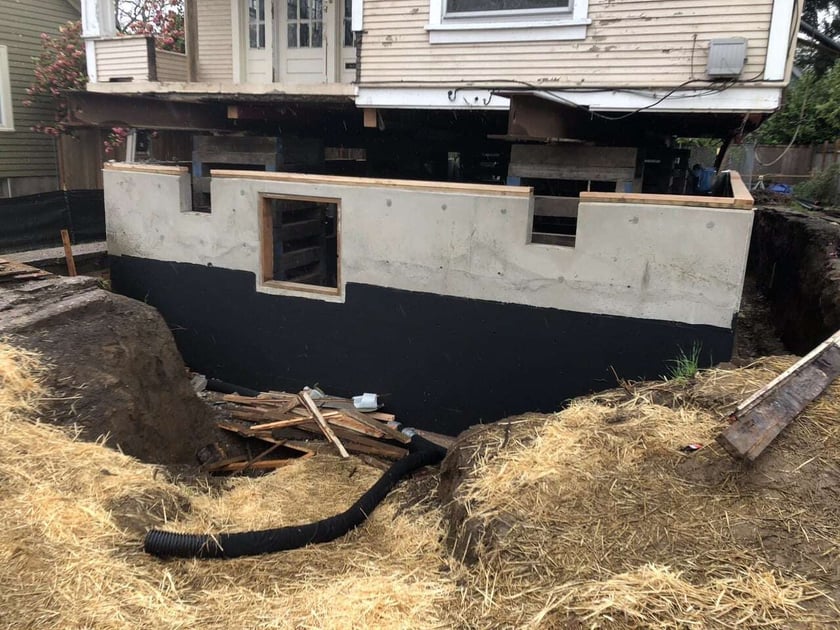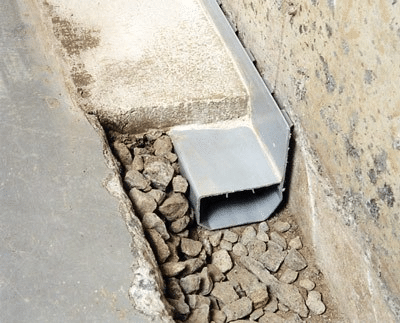Whether used for storage or living space, a basement can be a useful feature to any home. However, due to being located below ground, they can also be prone to water intrusion. For this reason, it’s a good idea to waterproof your basement and keep your home safe from water damage.
As one of Oregon’s top remodeling companies, Lamont Bros. has renovated plenty of basements across the Portland metro area. Over the years, we’ve seen many basements that suffered from water leaks. In these cases, we worked with the homeowners to waterproof the space and make it more usable.
This article will address the importance of basement waterproofing and the different methods used to do it. Once you’ve finished reading, you’ll have a clearer understanding of how to waterproof your basement. With that information, you can make an informed decision as to whether your own home basement might need waterproofing. We’ll discuss:
- The importance of basement waterproofing
- Potential sources of basement leaks
- Different options for waterproofing your basement
Why is it important to waterproof a basement?
Depending on the severity of the leakage and the way you intend to use the space, there are several reasons why you might want to waterproof your basement. Here are a few of the most common ways that basement waterproofing can benefit a home.
Prevent structural damage to the home
When water infiltrates the basement, it can cause the concrete to expand and contract, which in turn can cause the walls to crack, shift, or even crumble. Since your entire home sits on top of it, a compromised foundation can pose serious structural concerns.
Moisture can also cause wood, drywall, and insulation to decay, further compromising the stability and energy efficiency of the home. If not addressed quickly, water damage can result in costly repairs or even a total foundation replacement.
When it comes to waterproofing your basement, an ounce of prevention is worth a pound of cure. The cost to waterproof your basement now can save you tens of thousands in repair costs down the road.

Reduces moisture-related health hazards
Constant moisture in a basement can have a negative impact on indoor air quality and cause respiratory problems, allergies, and other health issues. This is most commonly associated with mold and mildew growth, which thrive in cold, damp environments like a moist basement.
These fungal organisms release spores that can become airborne and circulate throughout your home, which can cause respiratory illness. Additionally, moisture in your basement may attract pests such as rodents and insects, which can also pose a serious health and safety concern.
By waterproofing your basement to maintain a dry and healthy environment, you can reduce the risk of health hazards in your home and ensure a safer living space for you and your family.
Make your basement more usable
Having a dry basement makes it more suitable to use as a living space. For this reason, waterproofing is a common first step in the process of remodeling a basement.
When you invest money to finish or renovate your basement, you want to make sure that investment is protected. By first waterproofing the space before remodeling it, you can ensure that water damage does not threaten the quality or structural integrity of the final build.
Also, because it reduces moisture-related health hazards, waterproofing can also help the basement function better as a living space in regards to comfort and safety, as well.
What are some common causes of basement water leaks?
The first step in waterproofing a basement identify the source of the water leak. There are several different causes of water leaks in a basement. The best solution for waterproofing the space will depend on the type and severity of the leak.
Surface runoff
Surface runoff occurs when water from rain or melting snow flows over the ground and into your home’s drainage systems, such as gutters or storm sewers. If these systems are not working properly or are overwhelmed by the volume of water, this runoff can pool around the foundation of your home and seep through the concrete.
It’s also possible for surface runoff to flow toward your foundation from patios, driveways, or sloped properties neighboring your own. Any one of these factors may contribute to a high saturation of water around your home’s foundation.
Groundwater
Also called a natural water table, groundwater is the water that exists naturally below ground in the soil and rock layers. If your home is located in an area with a high water table, the groundwater can collect around your foundation and cause hydrostatic pressure against your basement walls. This pressure can force water into your foundation through cracks or gaps in the walls or basement windows, leading to basement water leaks.
False water table
In some cases, a basement water leak may be due to a phenomenon known as a false water table. This occurs when a home’s foundation was not properly backfilled after excavation, resulting in loosely packed dirt around the foundation walls. Because it is not hard-packed, this dirt can hold a higher saturation of water, which can exert hydrostatic pressure on the walls of your foundation.
The reason it is called a “false” water table is that it is not naturally occurring. A false water table only lasts for a short time and sits up higher than a naturally occurring one. However, it can still cause serious damage to your home’s foundation. The most common point of failure for a false water table is the joint between the slab and the foundation wall, called the cold joint.
Compromised foundation
If your foundation is already damaged, this can exacerbate the severity of water intrusion. Whether it is due to years of hydrostatic pressure or simply poor construction, a cracked or porous foundation can allow water through at a much higher rate than an uncompromised foundation under the same conditions.
Many homes in the Portland area were built in the early 1900s, before concrete mixtures or foundation construction methods were perfected. As a result, many homes in this area are prone to foundation cracking or shifting, which in turn can worsen any existing water leakage.

What are the options for waterproofing a basement?
Once you understand the source of the water leak, you can then begin to formulate a plan to solve it. There are three common methods of waterproofing a basement. Each one comes with its on advantages and drawbacks.
Stop the water at the source
In some rare cases, you can “waterproof” your basement without even having to touch the basement itself. Rather, you can solve the leakage issues by simply redirecting the water from its original source.
This solution is most commonly used when dealing with basement leaks caused by surface runoff. By upgrading the drainage systems on the home and directing the flow of water away from the foundation, you can significantly reduce the soil saturation and risk of water leaks.
The challenge with this approach is that it can be difficult to test how effective the changes are. Instead, you’ll simply have to wait and see if diverting the surface runoff reduces the amount of water intrusion or if further waterproof efforts are still needed.
It’s important to note that if you go this route, you’ll need to have a professional engineer develop a plan. This will ensure that the efforts you make to reduce the water leaks in your basement have the highest chance of success.
Waterproof the exterior of the foundation
Exterior waterproofing is typically the most complicated way to waterproof a basement. However, it also happens to be the most effective way to keep your basement dry. You’ll want to hire a qualified contractor to perform a job like this. Mistakes can be costly and affect the safety of your home.
During an exterior waterproofing project, the entire outer wall of your basement foundation is excavated to check for leaks, cracks, or other damage that may cause water leakage. Once these issues have been identified and repaired, the contractor will then install a drainage system around the exterior of the home, typically in the form of a French drain.
After installing the drainage system, the contractor should install a waterproof membrane around the exterior foundation wall. This is typically a thick, rubberized coating that prevents water from penetrating the foundation walls.
Once the waterproofing membrane is applied, the soil can be backfilled around the foundation walls. The soil should be carefully compacted to ensure that it does not settle or shift over time.
Keep in mind that, while often effective in keeping out water, an exterior waterproofing approach is very expensive and intrusive. It requires many labor hours, heavy equipment rentals, and will likely make a mess of your yard’s landscaping.

Waterproof the interior of your home
A solution for homeowners who don’t mind a little water getting into the basement as long as it’s managed, interior waterproofing tends to be more affordable and less invasive.
If you choose to use an interior waterproofing method, you’ll need to accept that some water will still get into your basement foundation. Rather than attempt to keep water out, interior waterproofing aims to capture, control, and discharge water from the basement if it does get in.
The primary practice for interior basement waterproofing is to install a French drain around the interior perimeter of the basement floor. Then, a sump pump within the basement drain system expels the water from the basement and into the exterior drain field.
Interior waterproofing projects can be expensive when installing them in a finished basement. It requires demolishing many of the finished surfaces to get to the slab perimeter, including drywall and flooring. This is why it’s best to do this type of project as part of a larger remodel.

Considering a basement remodel? Let’s talk about it!
After reading about the different types of basement waterproofing projects, do you have a better idea of which one is the right option for you? If so, continue researching your options and exploring potential contractors for the job. For inspiration on basement remodeling projects, check out our Basement Portfolio, where you can see photos of past projects by our team at Lamont Bros.
Want to know if a full-scale basement remodel is right for you? If so, click the button below to schedule a free design consultation with a member of our design team. We’ll help you explore your remodeling options so you can confidently choose the one that best fits your needs as a homeowner.



